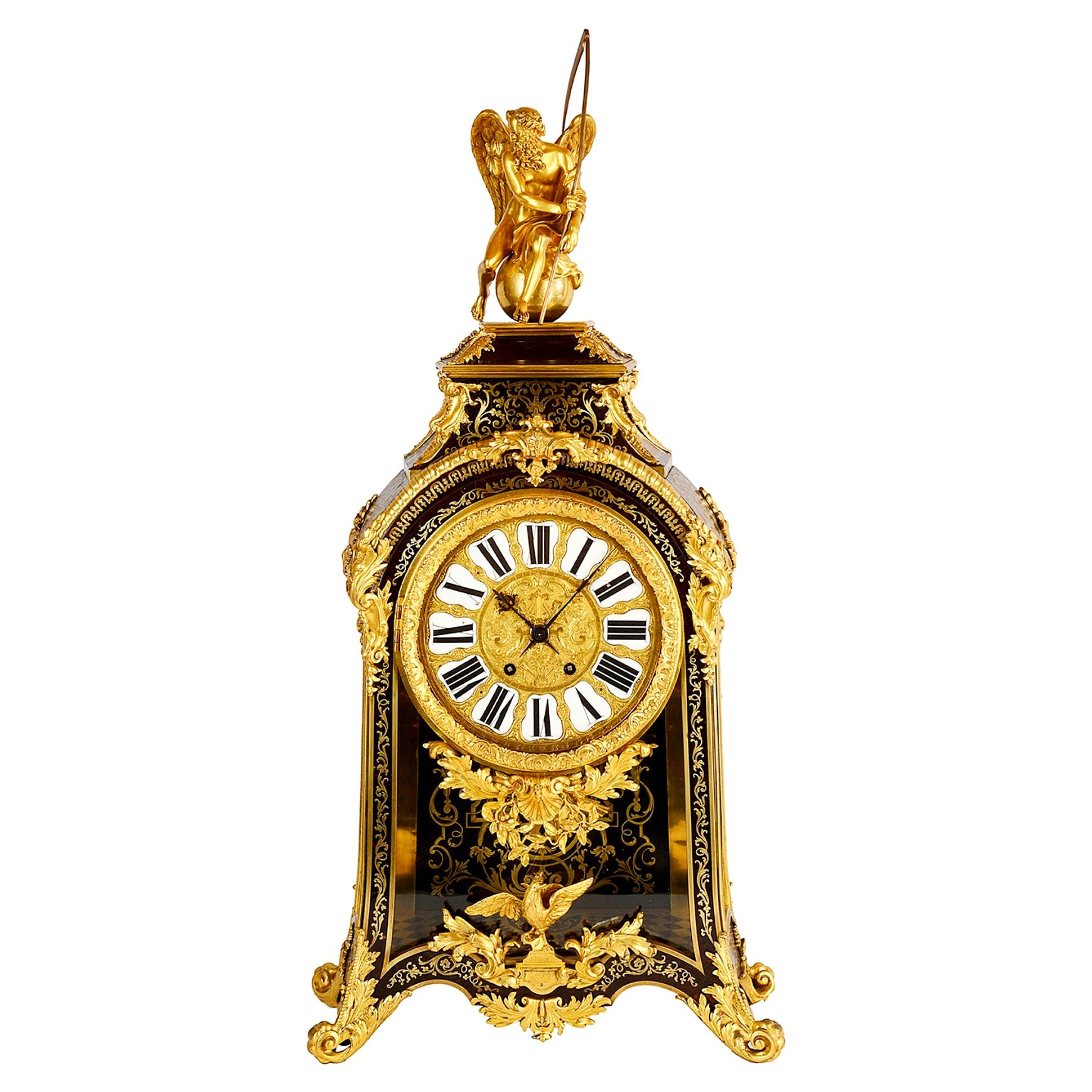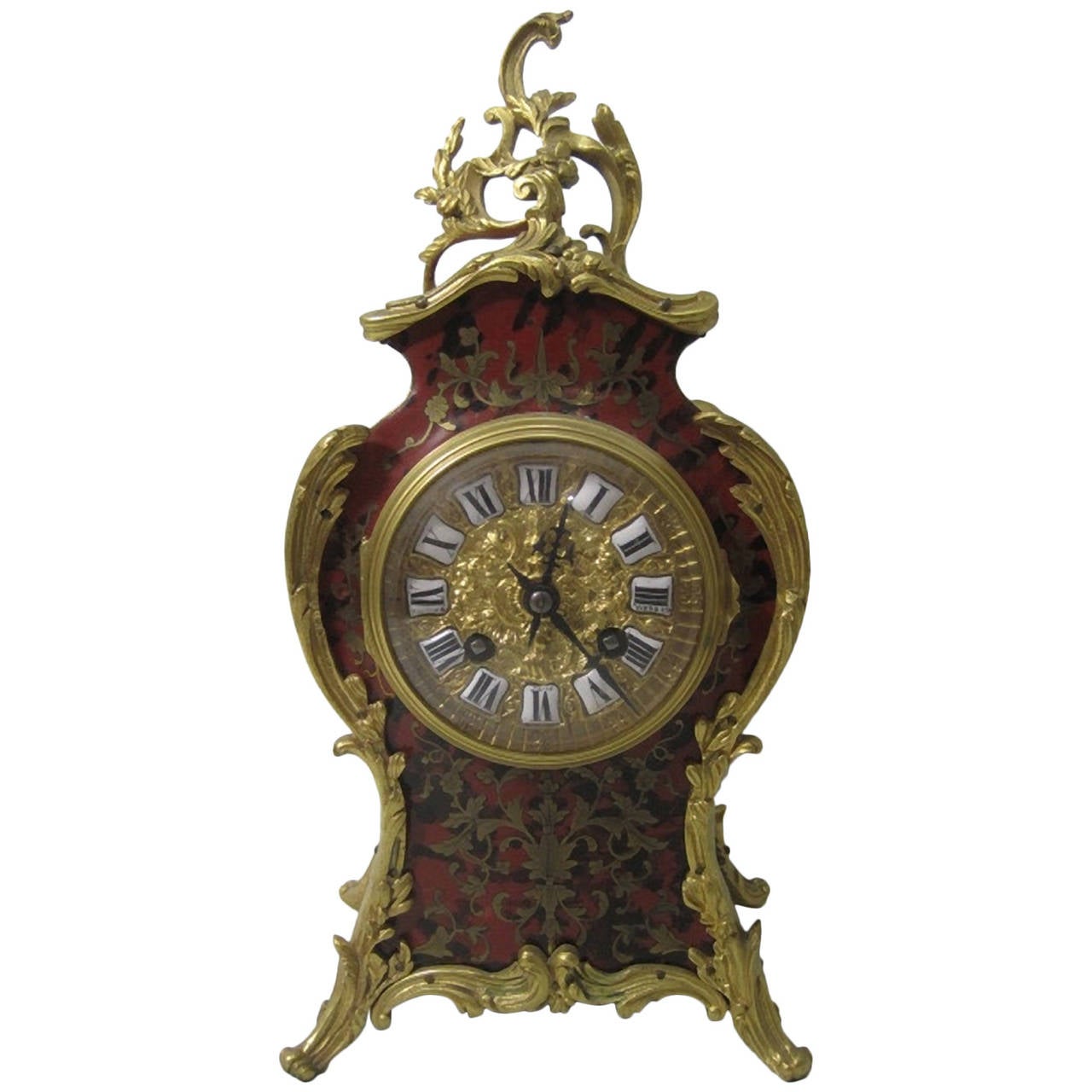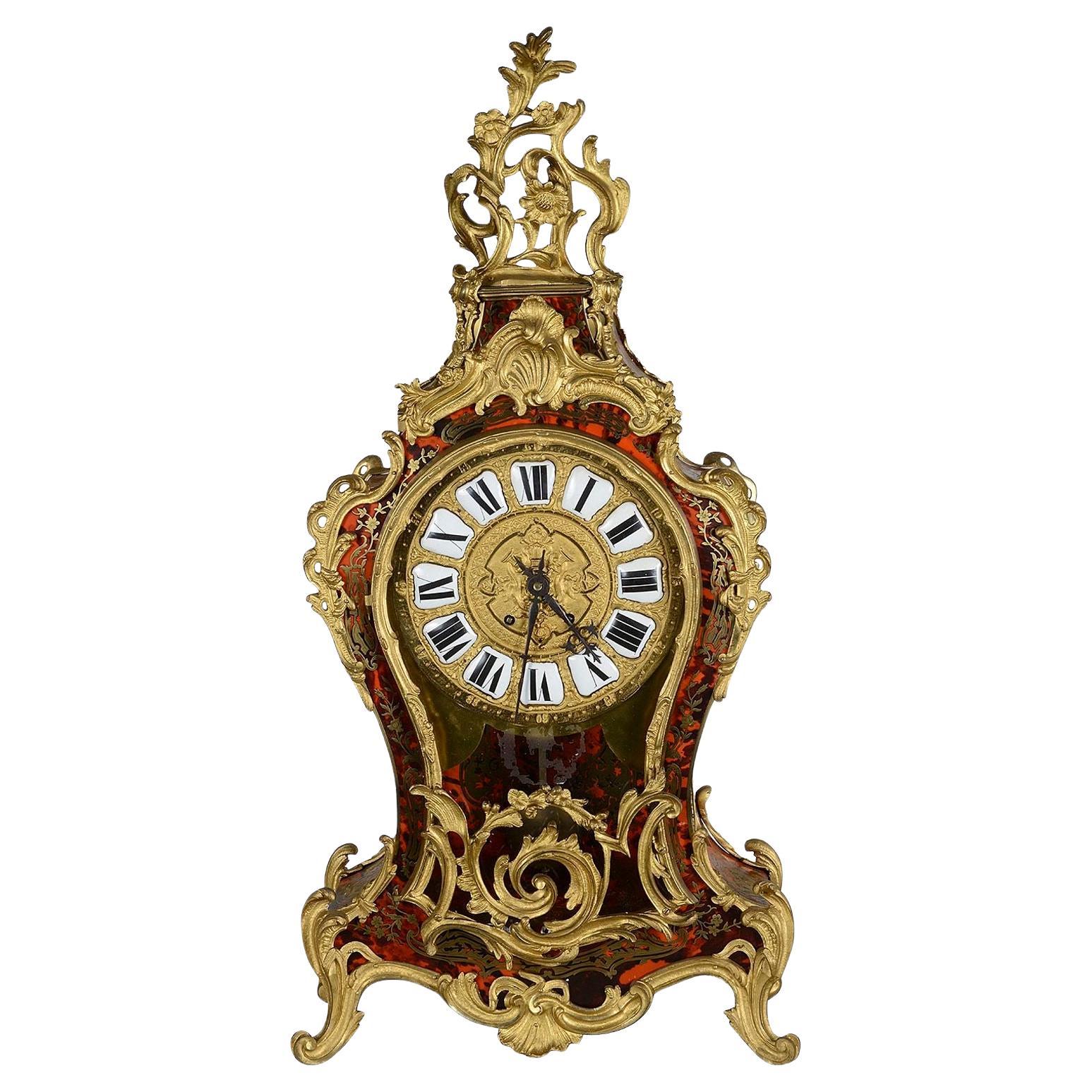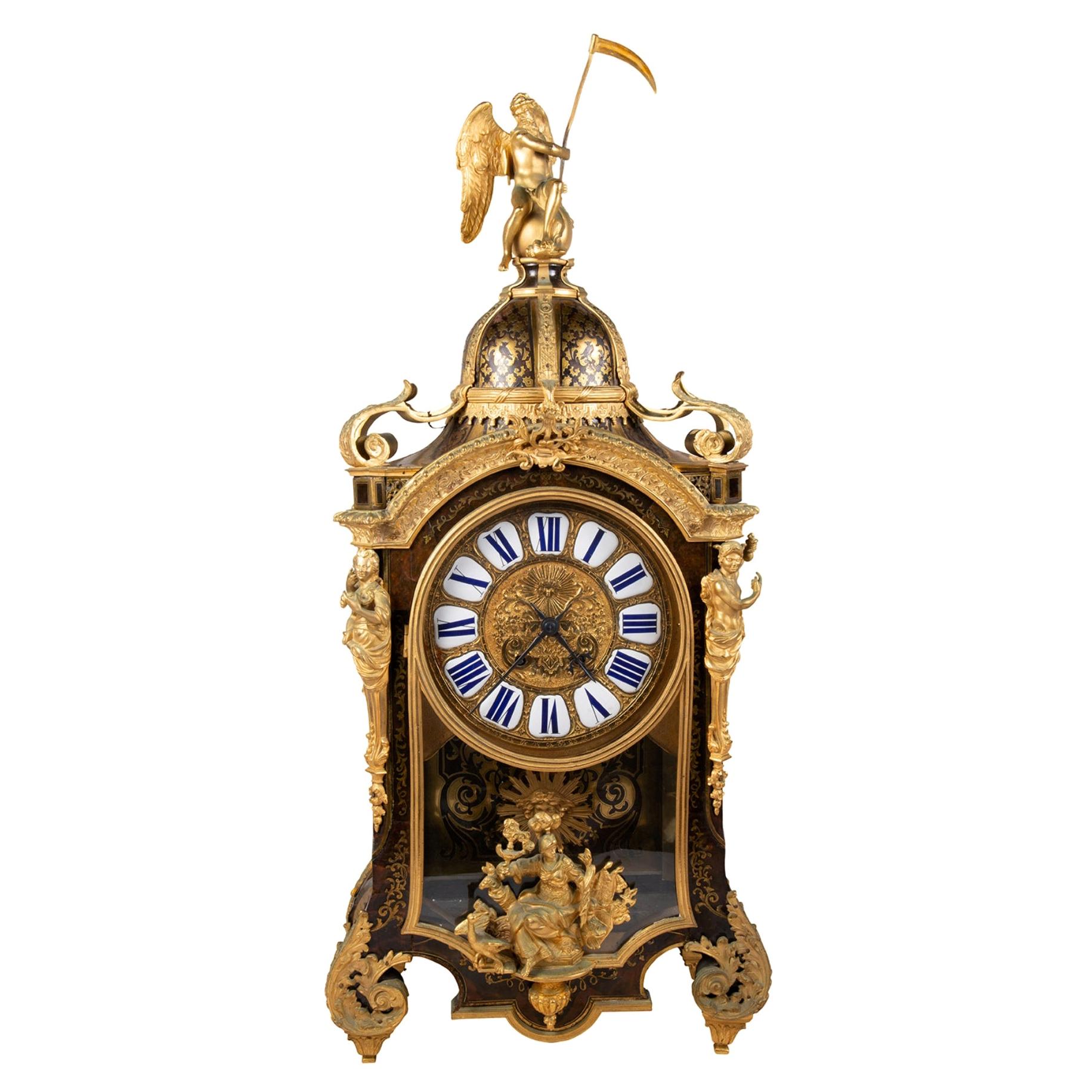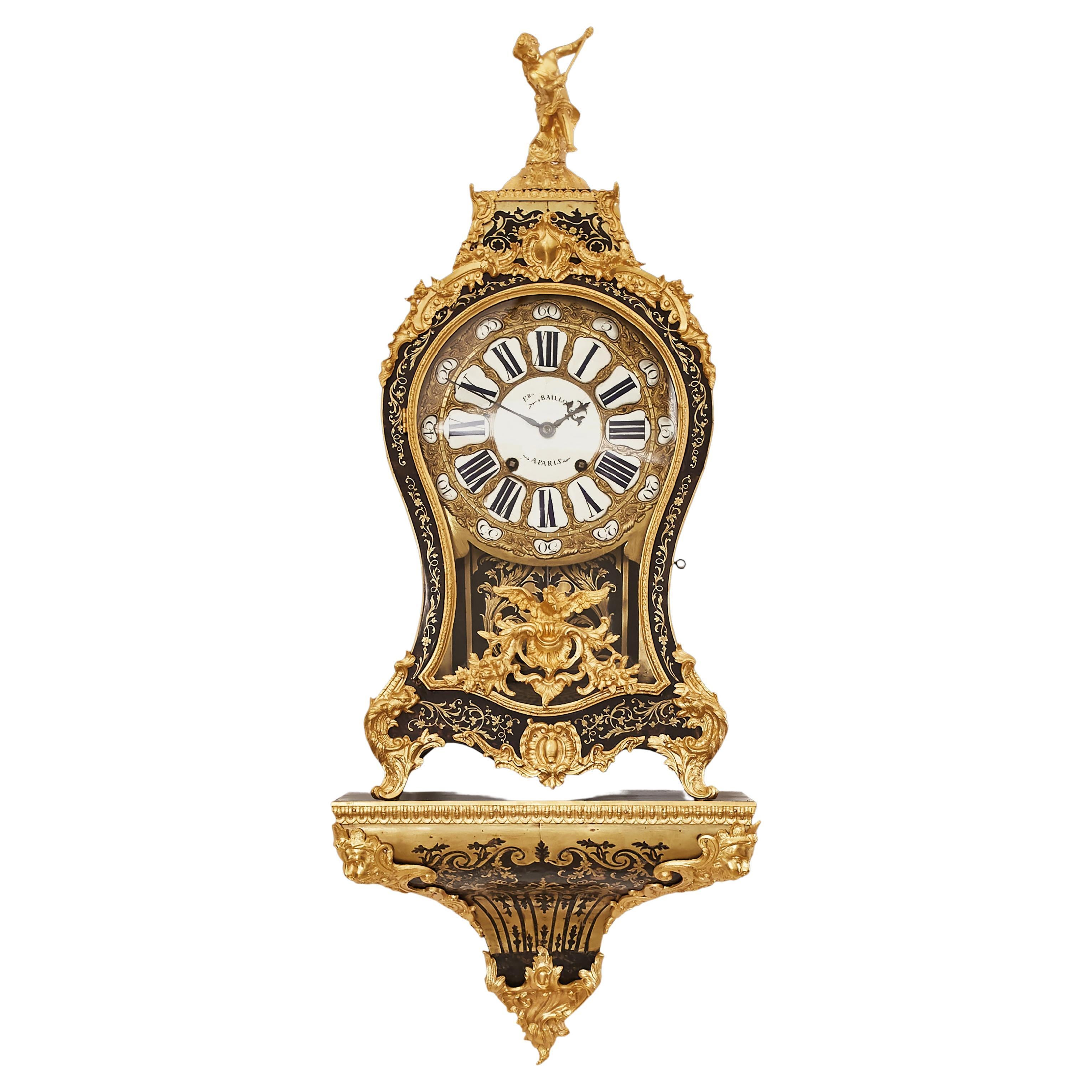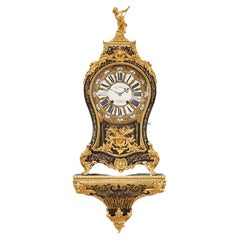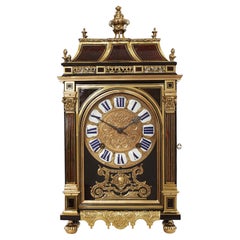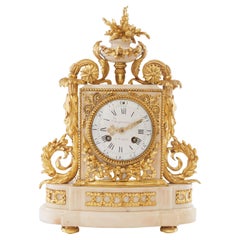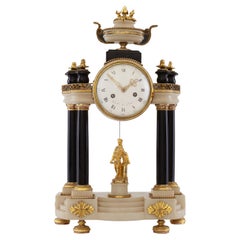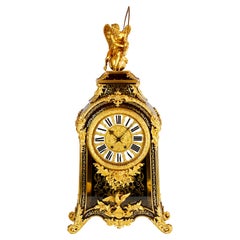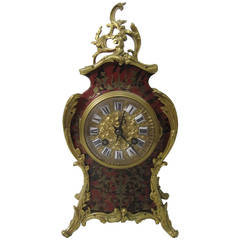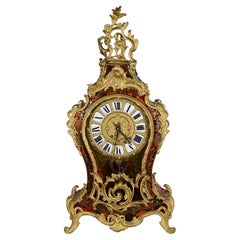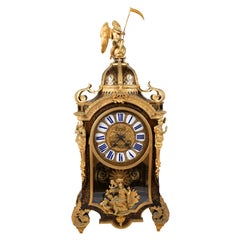Items Similar to Mantel Clock 18th Century Styl Boulle by Josue Panier À Paris
Want more images or videos?
Request additional images or videos from the seller
1 of 8
Mantel Clock 18th Century Styl Boulle by Josue Panier À Paris
$6,223.03
$9,573.8935% Off
£4,658.62
£7,167.1035% Off
€5,200
€8,00035% Off
CA$8,566.78
CA$13,179.6635% Off
A$9,365.17
A$14,407.9535% Off
CHF 4,954.60
CHF 7,622.4535% Off
MX$112,069.29
MX$172,414.2935% Off
NOK 63,040.11
NOK 96,984.7835% Off
SEK 57,706.84
SEK 88,779.7635% Off
DKK 39,617.60
DKK 60,950.1535% Off
About the Item
This magnificent mantel clock is a testament to the exquisite craftsmanship and refined aesthetic of 18th-century French horology. Attributed to Josué Panier, a renowned clockmaker of the period, this timepiece showcases a harmonious blend of form and function, typical of the style, with a strong emphasis on classical motifs and decorative elements.
The clock is presented in a classic architectural form, with a central clock face framed by a dramatic architectural composition. The case is adorned with intricate Boulle marquetry, a technique involving the inlaying of brass and ebony to create stunning geometric and floral patterns. This intricate work is further enhanced by the addition of gilded bronze mounts, featuring meticulously crafted acanthus leaves, floral swags, and possibly other decorative elements.
Above the clock face, a sculptural group, likely depicting a mythological scene, adds a dramatic and decorative element. The clock rests on a base embellished with further Boulle marquetry and gilded bronze mounts, creating a visually striking and opulent effect.
Key Features:
Boulle Marquetry: The use of ebonized wood and brass marquetry is a defining characteristic of this style, creating a visually striking and luxurious effect.
Gilded Bronze Mounts: The addition of gilded bronze mounts enhances the overall visual impact and adds a touch of opulence.
Sculptural Elements: The inclusion of a sculptural group adds a dramatic and artistic dimension to the clock.
Attributed to Josué Panier: The attribution to Josué Panier, a renowned clockmaker of the period, lends significant historical and artistic value to the clock.
Decorative Potential: This clock would make a stunning addition to any grand residence, serving as a centerpiece on a mantelpiece, console table, or as part of a larger display.
- Dimensions:Height: 30.71 in (78 cm)Width: 14.57 in (37 cm)Depth: 6.7 in (17 cm)
- Style:Louis XVI (In the Style Of)
- Materials and Techniques:
- Place of Origin:
- Period:
- Date of Manufacture:1740-1760
- Condition:Repaired: The clock is in excellent and perfect working condition. In addition, it was recently cleaned and serviced by a professional clockmaker who specializes in maintaining museums. The eight-days going movement has a wire suspension pendulum, It strikes t.
- Seller Location:Warsaw, PL
- Reference Number:1stDibs: LU5826225741952
About the Seller
5.0
Vetted Professional Seller
Every seller passes strict standards for authenticity and reliability
Established in 2021
1stDibs seller since 2021
34 sales on 1stDibs
Typical response time: 10 hours
- ShippingRetrieving quote...Shipping from: warsaw, Poland
- Return Policy
More From This Seller
View AllWall Clock 18th Century Boulle
By André-Charles Boulle
Located in Warsaw, PL
Exquisite Boulle Style Mantel Clock
This exquisite mantel clock perfectly embodies the artistry and elegance of the Boulle style, characterized by its rich ornamentation in bronze an...
Category
Antique Late 19th Century French Louis XV Wall Clocks
Materials
Bronze
$18,669 Sale Price
22% Off
Mantel Clock 18th Century Louis Xv Period by Estienne Menu À, Paris
Located in Warsaw, PL
This stunning antique bracket clock is a fine example of luxurious 18th-century European design, combining meticulous craftsmanship with timeless...
Category
Antique Late 18th Century French Louis XV Table Clocks and Desk Clocks
Materials
Bronze
Mantel Clock 18th Century Louis XV Period, by Seigneurel À Paris
Located in Warsaw, PL
A Louis XV style marble mantel clock. Enamel dial with Roman numerals, signed with a red inscription "Seigneurez A Paris", finely pierced, engraved gold-plated hands, a broken arch (...
Category
Antique Late 18th Century French Louis XV Mantel Clocks
Materials
Malachite
$3,111 Sale Price
25% Off
Mantel Clock 18th Century Louis XV Period by Gavelle L'e Aaria
Located in Warsaw, PL
Antique French portico clock is crafted in Empire style during the reign of Napoleon in the 19th century. The Empire style gives the antique clock...
Category
Antique 18th Century French Louis XV Mantel Clocks
Materials
Marble
$1,866 Sale Price
37% Off
Mantel Clock 19th Century Louis XV Period
Located in Warsaw, PL
An exquisite 19th-century Louis XV-style mantel clock, showcasing a harmonious blend of Neoclassical and Rococo influences. This elegant timepiece features a finely crafted white ena...
Category
Antique Late 18th Century French Louis XV Mantel Clocks
Materials
Marble, Bronze
Mantel Clock 18th Century, Louis XV Period
Located in Warsaw, PL
This striking mantel clock is a fine example of the Empire style, a period characterized by its grandeur and inspiration from classical antiquity. The clock showcases a masterful com...
Category
Antique Late 18th Century Louis XV Mantel Clocks
Materials
Marble
You May Also Like
19th Century French Boulle Mantel Clock
By André-Charles Boulle
Located in Brighton, Sussex
A very impressive 19th century French Boulle inlaid mantel clock. Having a gilded ormolu figure of father time to the top, beautiful brass inlaid decoration to the sides and front. T...
Category
Antique 19th Century French Louis XVI Mantel Clocks
Materials
Brass
19th Century French "Boulle" Mantel Clock, Louis XV Style
Located in Hamilton, Ontario
19th century French "Boulle" mantel clock, Louis XV style.
French Boulle style clock with tortiose shell and inlay. Gilt bronze case mounts of ro...
Category
Antique 19th Century French Louis XV Mantel Clocks
$3,595 Sale Price
20% Off
C19th French Louis XVI style Boulle mantel clock. 86cm high
By André-Charles Boulle
Located in Brighton, Sussex
An impressive 19th Century French Louis XVI style, Boulle mantel clock, having red stained Tortoiseshell veneer to the case, gilded Rococo influenced ormolu mounts, white enamel Roma...
Category
Antique Late 19th Century French Louis XVI Mantel Clocks
Materials
Ormolu
Louis XVI Boulle mantel clock, 19th Century.
By André-Charles Boulle
Located in Brighton, Sussex
A very good quality 19th Century French Louis XVI style Boulle mantel clock, having Father Time perched above the brass inlaid dome, scrolling foliate ormolu mounts, white enamel Rom...
Category
Antique 19th Century French Louis XIV Mantel Clocks
Materials
Brass
19th Century French Boulle Mantel Clock
By André-Charles Boulle
Located in Brighton, Sussex
A very good quality 19th century French Boulle inlaid mantel clock having wonderful classical brass inlay to the tortoiseshell ground, a gil...
Category
Antique 19th Century French Louis XVI Mantel Clocks
Materials
Brass
Large 18th Century French Louis XV Gilt Bronze Boulle inlaid Mantel Clock
Located in New York, NY
Very large (40 inch tall) ormolu bronze mantel clock from the Louis XV period with Boulle style inlaid brass and enamel decorations with original pendulum. By the Paris maker, Denis ...
Category
Antique 18th Century French Louis XV Mantel Clocks
Materials
Bronze, Enamel
More Ways To Browse
Orologio Vintage
Tiffany And Co Clock
Mechanical Desk
United Clocks Deco
Italian Brass Clock
Clocking Machine
Italian Bronze Clock
Art Deco Enamel Clocks
Homer Watch
Wood Art Deco Clock
Black Enamel Clock
Antique Italian Clock
Antique Italian Clocks
Antique Watch Makers
Brass Zodiac
Italian Gold Clock
Jaeger Lecoultre Table
Kitchen Clocks
